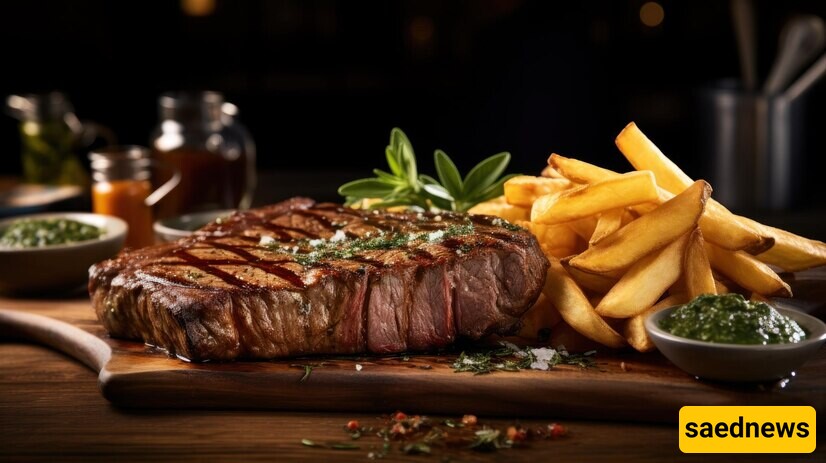SAEDNEWS: Cooking steak, like any other dish, requires some tricks and techniques, but sometimes we make mistakes while cooking it. Familiarize yourself with these common mistakes when cooking steak to ensure a perfectly cooked, delicious steak every time.


You might fear over-seasoning your steak or making it too salty, but trust us: there’s no need to be cautious when it comes to seasoning. Without properly seasoning the steak from the inside, you'll miss out on a strong flavor. Therefore, season the meat from the inside and both sides 35 to 40 minutes before cooking.
When it comes to steak, waiting is tough, but you should never place a steak directly from the freezer onto the grill. Plan ahead and let the meat reach room temperature. A cold steak won't cook evenly, causing the outside to burn while the inside remains undercooked. Depending on the size of the steak, let it sit at room temperature for 30 minutes to 2 hours. While waiting, enjoy an appetizer to curb your hunger.
Selecting a steak isn't just about picking it from the cooler and placing it on the checkout counter. There are various types of steaks, and not all are cooked the same way. For example, T-bone steak should be grilled, while ribeye steak is better cooked in a frying pan due to the fat that renders out of the meat. Cooking all steaks the same way deprives you of the best possible flavor. Choose your preferred cooking method and remember that the more expensive cuts are typically better for frying, so choosing the right steak is crucial.
Lean cuts have their place, but they aren't suitable for cooking steak. Lean cuts usually turn out tough and dry, while fat provides the most flavor. If you're looking for a lighter dish, improve your barbecue skills and try honey-lemon grilled chicken. Choose a steak with enough fat, which might be slightly more expensive but is worth it for the tenderness and juiciness.
There's a common misconception that for a juicy and flavorful steak, you should only flip it once. While this might result in a visually appealing steak, it often isn't very tasty; in fact, this method can dry out the steak. Get into the habit of flipping the steak multiple times while cooking, especially at high temperatures. Frequent flipping speeds up the cooking process (by up to 30% faster than flipping only once), resulting in a juicy steak that's more evenly cooked without over-browning the edges.
It's logical to buy meat along with your other groceries at the supermarket, but if you want a great steak, go the extra mile to buy it. If you want to cook like a professional, trust a professional butcher to start. Visit your local butcher; they can help you identify the best cuts and offer lesser-known options.
Freshly cooked steak is very tempting, but resist the urge to eat it immediately. Like many other foods, steak needs time to rest. As the meat cooks, its fibers contract and release moisture, making the steak juicy. If you cut the steak immediately after cooking, this moisture will spill out onto the plate, leaving the steak dry and tasteless. Wrap the meat in foil and let it rest for 5 minutes for thinner cuts and 15 minutes for thicker cuts. This allows the fibers to reabsorb the juices, making the steak more succulent.
No matter how experienced you are at grilling, you can't accurately judge a steak's doneness by just looking at it. The outside might look promising, but the inside could be undercooked. Using a fork to check doneness lets the juices that make the steak flavorful escape. Therefore, use a good meat thermometer: 135°F for medium-rare, 140°F for medium, and 145°F for well-done. These temperatures might seem lower than what you usually use because of a process called carryover cooking, where the steak's internal temperature increases as it rests after being taken off the grill.
Olive oil is popular for its health benefits and flavor it adds to sauces, but when cooking at high temperatures, put the olive oil away. Its smoke point is relatively low at about 320°F. Beyond this point, it produces bad flavors and harmful chemicals. Because steaks cook at temperatures up to 500°F, using olive oil can fill your kitchen with smoke and make the steak taste bad. Butter is also unsuitable due to its low smoke point. Use lighter oils with higher smoke points, such as peanut or canola oil.
Nothing is worse than not cleaning the grill. Food residue on the grill grate makes it sticky and causes the meat to stick and tear. Clean the grill after each use; while the coals are still hot, use a wire brush to scrape off food residue. Apply a small amount of oil to the grate, and your grill will be ready for the next use.

